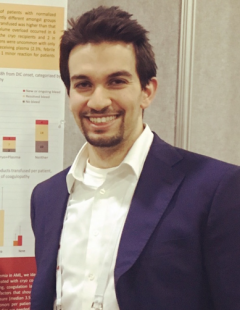Pouneh Kermani, PhD
My research interests focus on understanding blood vessel formation during development and diseases. I obtained my Ph.D from University of Montreal (Canada) and completed my postdoctoral training at Weill Cornell Medical College. The communication between cells and their local environment is essential for development, homeostasis, repair and regeneration of the tissue. Our research focuses on deciphering the molecular pathways involved in the interaction of hematopoietic cells and endothelial cells in the bone marrow microenvironment. Our primary goal is to define how Laminin, most intimate matrix protein in contact with endothelial cells, and its receptor regulate the function of hematopoietic cells in normal and diseased bone marrow. Our analysis involves molecular genetics, dissection of TGF β signaling pathway and live/fixed cell imaging. The main goal of my research is to achieve development of clinically relevant drugs to treat MPNs and other hematological diseases.
Silvana Di Giandomenico, PhD
Chronic anemias are a major medical problem with therapeutic options limited to blood transfusions and erythroid stimulating agents (ESAs). Unfortunately, transfusions and ESAs are expensive, time consuming and very often ineffective. New approaches for treating chronic anemias are needed. It takes about 3 weeks for immature hematopoietic stem and progenitor cells to differentiate into red blood cells (RBCs). There is a lot known about the final 3 cell divisions leading to RBCs. Surprisingly little is known about how these terminal stages of erythropoiesis are matched by bone marrow production of more immature erythroid progenitor cells. My project is identifying how production of red blood cell progenitors in the bone marrow is coupled to terminal erythroid maturation. My work promises new therapies for chronic anemias to increase the outflow of immature progenitors with ESAs to support erythroid maturation. This work is particularly relevant to MPNs because abnormal red blood cell production is a recurrent problem in these disorders either due to overproduction of unneeded RBCs (PV) or underproduction leading to anemia (MF).
Ghaith Abu Zeinah, MD
My medical career took me on a path far from my home in Jordan, but brought me closer to my goal of becoming a hematologist-oncologist with a focus in Myeloproliferative Neoplasms (MPNs). Graduating with a Medical Doctorate from Weill Cornell Medical College in Qatar and then completing my residency training in Internal Medicine at the New York Presbyterian/Weill Cornell has facilitated my transition into fellowship in Hematology and Oncology here at Weill Cornell, an institution renowned for its expertise in MPNs.
During my fellowship training, I joined the lab of Dr. Joseph Scandura with the goal of identifying therapeutic mechanisms and novel targets in classical Philadelphia-negative MPNs. This entails bridging the scientific basis of disease propagation with the clinical aspects of disease management; a bedside to bench approach that translates back to the bedside.
As I near the completion of my fellowship training, I look forward to assuming the role of a hematologist providing excellent care to my patients and involving them in research that may benefit them and definitely benefit generations to come.
Nassima Messali, Ph.D.
My graduate training was in T cell biology at the Pasteur Institute in Paris. I have since joined the Scandura Lab to develop a novel technology through which blood vessel lining endothelial cells can be converted into hematopoietic stem cells (Endothelial to Hematopoietic Stem Cell Conversion). I’m performing a series of proof-of-principle experiments using this exciting technology that I hope will lead to new curative cell therapies for MPNs. This is a high bar but I think something we can achieve in the coming years. We are also using this technology to rapidly develop human and murine MPN models for forward genetic screens.
Mia Yabut Wiese
Mia is a technician in the Scandura Lab. Her work focuses on the mechanism that controls hematopoietic stem cell "hibernation." She also works with post-doctoral fellow, Nassima Messali, to convert endothelial cells into hematopoietic stem cells. This work will allow us to re-create MPNs in mice so we can study these diseases in vivo. Mia plans to attend graduate school to continue studying hematopoiesis as it relates to MPNs.
Scandura Lab Alumni
Nicole Mollé
Nicole was a research technician in the Scandura Lab and is now a grad student at the Weill Cornell Medicine Neurosciences program. During her time in the Scandura Lab, she investigated the role of extracellular matrix on myeloproliferative neoplasms in an effort to better understand the microenvironment of these diseases that can contribute, and perhaps dictate, the potential outcomes of these malignancies. These projects focused on elucidating ky mechanisms to understand how extracellular proteins secreted at the cell surface play a role in signal transduction pathways commonly aberrant in MPNs. By understanding the biology supporting these cell-ECM interactions we can develop better targeted therapies for treating MPNs.




